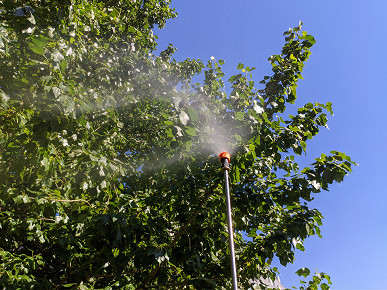Garden sprayers are rare guests in our test lab. That makes it all the more interesting for us (and you) to get to know these devices better and find out what they can do.
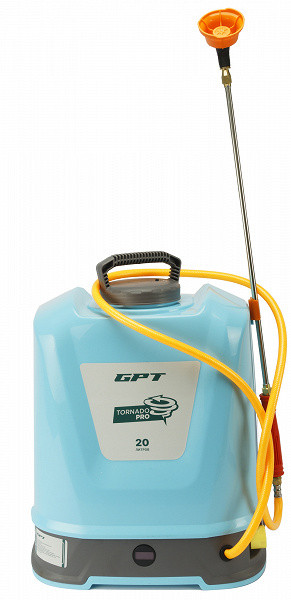
Today we are reviewing a powerful and large battery garden sprayer Garden&Power Tools called Tornado Pro. The model with the index ZFB-20 hints at a tank capacity of 20 liters.
Characteristics
| Manufacturer | Garden & Power Tools |
|---|---|
| Model | Tornado Pro ZFB-20 |
| Type | battery powered garden sprayer |
| Country of origin | China |
| Guarantee | 12 months |
| Service life * | 24 months |
| Liquid tank capacity | 20 l |
| Working pressure | 8.3 bar |
| Barbell | telescopic 50-95 cm |
| Length of straps | 0.8-1.1 m |
| Battery | PB (lead), 12 V, 12 Ah |
| Additionally | 5 nozzles, double pump, mixing system |
| Weight | 7.1 kg |
| Dimensions (W×H×D) | 18×47×37 cm |
| Hose length | 1.5 m |
* Contrary to popular belief, this is not a period after which the device will necessarily break down. However, after this period, the manufacturer ceases to bear any responsibility for its functionality and has the right to refuse to repair it, even for a fee.
Equipment
The device is supplied in a cardboard package without handles. The printing is high-quality and full-color.
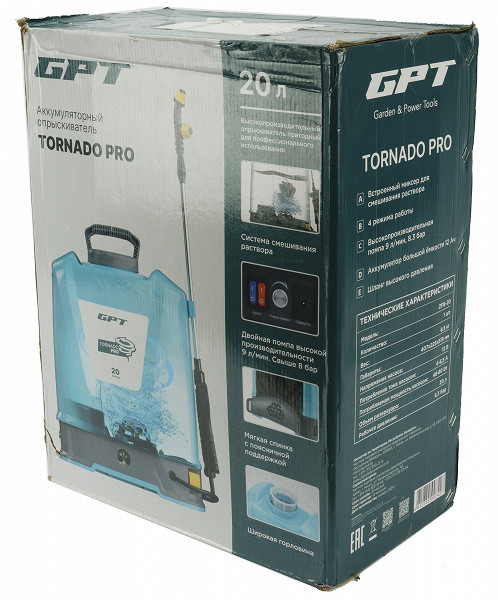
The box indicates the main technical characteristics and capabilities of the device, as well as a photograph of the assembled unit and images of the key elements of the model.
After opening the box, we found inside:
- the sprayer itself (battery-motor unit), made in the form of a plastic backpack with straps
- hose
- telescopic rod with tap
- five nozzles for spraying
- rod mount to the body
- back support
- plastic measuring cup with a capacity of 100 ml
- set of gaskets
- charger
- instructions and warranty card
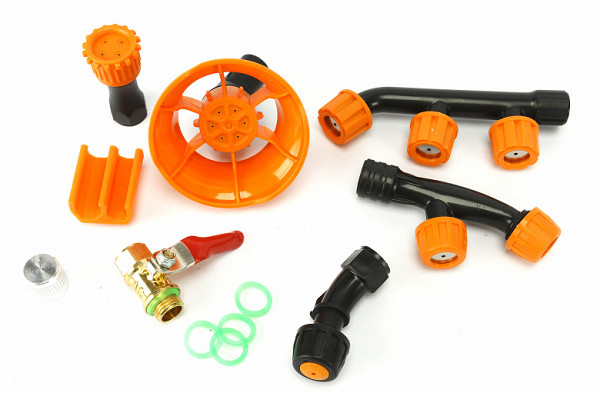
At first glance
At first glance, the device gives the impression of a reliable and serious device. The voluminous blue plastic backpack looks quite heavy and impressive, which immediately sets you up for a serious mood. You want to try it out as soon as possible! Let's take a closer look at all the elements of the device.
The body of the sprayer is a large plastic tank of complex shape. In the lower part of the body there are two pumps, a battery and a control unit. We will talk about the controls in the corresponding section, but for now let's pay attention to the appearance of the device.

So, at the top we see a large plastic plug with a rubber valve that allows air to enter the tank...

...and under the lid there is a removable mesh filter.

On the lower part of the front side, in the center, there is a battery charge indicator. On the right is the place where the hose is attached (it is non-removable in our model).

The back of the case has a soft ergonomic EVA backrest. It helps reduce the load on the back and provides additional ventilation, preventing excessive sweating.

If necessary, an additional plastic waist support holder can be installed under the backrest. Its purpose is to reduce the load on the lower back and ensure a more comfortable fit of the backpack to the user's back.
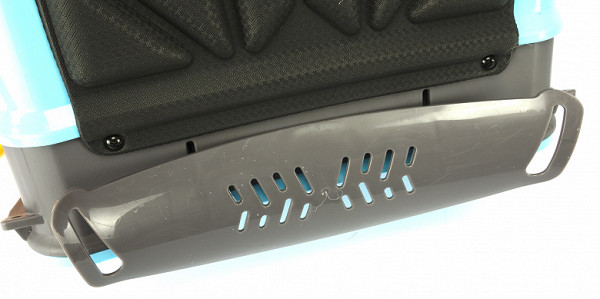
On the back side, straps with pads made of the same EVA material are also installed.
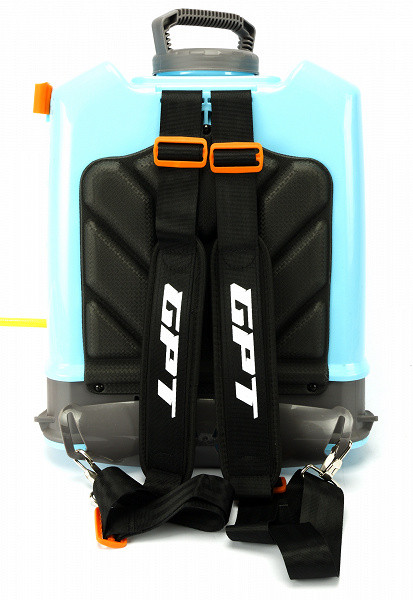
The stainless steel telescopic tube is connected to the hose via brass threaded fittings. The length of the tube can be adjusted between 50 and 95 cm. A simple metal shut-off valve is installed in front of the tube.

The sprayer nozzles are made of plastic and are attached to a thread, which makes it easy to remove them for cleaning. The set includes five nozzles for different use scenarios.
One of them is designed for watering and has a shower type of spray.

Two — for precise spraying, with one and four holes.
Two more — for processing large areas, with two...
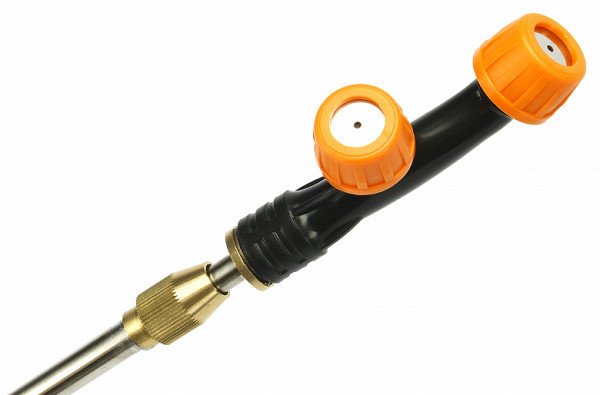
...and three spray heads.
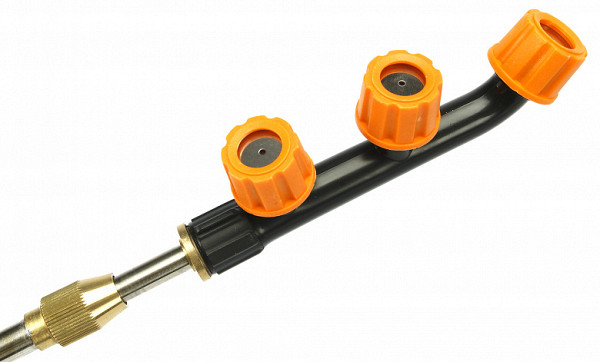
The charger connector is located at the bottom on the side (left) of the backpack.
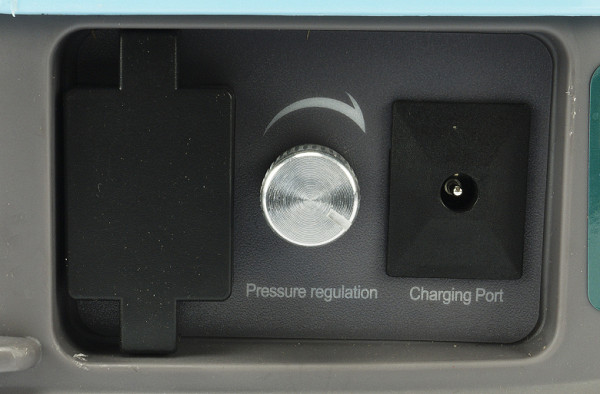
The charger provides 1A at 14.4V and has a 1.2m cable. It is important to note that the charger is for indoor use only. Charging the sprayer battery outdoors is at your own risk, provided there is no water nearby and there is no rain.

What's inside? There's a stirrer under the black plastic grate. It ensures uniform mixing of the solution, preventing liquids from separating and sedimentation, and allows you to prepare mixtures directly in the tank. For ease of preparation of mixtures, the kit includes a 100 ml plastic measuring cup, which allows you to accurately measure the volume of liquid in 5 ml increments.
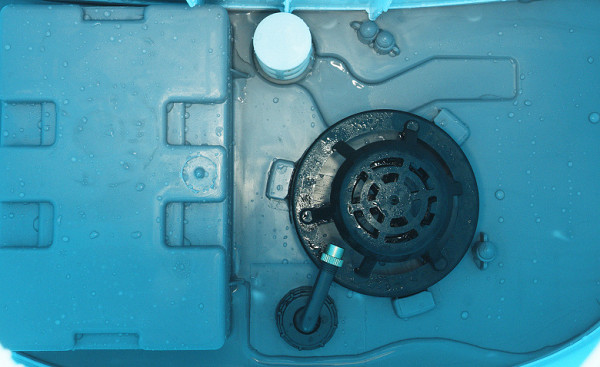
Water enters the pump through a small removable filter, which is a white plastic cap on the top. At the bottom is a tube designed to remove excess air from the pump chamber, with a small nozzle at the end that prevents too much air from escaping.
Also worth mentioning is the removable plastic mount located in the upper right corner of the backpack, which allows you to attach a telescopic tube. This is especially useful when carrying the device over a significant distance.
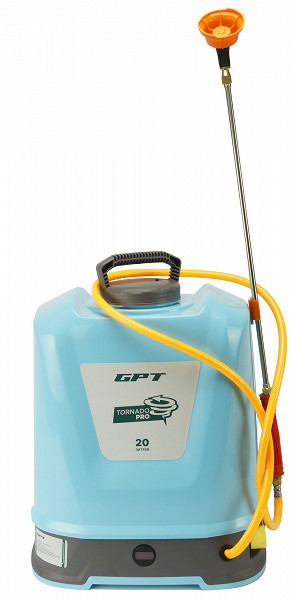
Instructions
The operating manual focuses on the description of the design, components, assembly instructions and connection of parts of the device, precautions, as well as storage and transportation conditions. It also includes a section on troubleshooting simple malfunctions and breakdowns.

It wouldn't hurt to read the brochure, but we won't find any special secret knowledge or revelations here. So, in principle, you can immediately proceed to exploitation.

Control
Our sprayer has several controls, and the purpose of some of them may not be obvious. However, once you figure it out, you can easily understand their functions.
The yellow plastic knob is used to select the operating mode of the device: spraying, spraying with stirring, or stirring only.

Our sprayer has two buttons, each of which controls one of the pumps and works independently of the other.
The rotary knob is responsible for variable pressure water supply, which may not be entirely intuitive. When the knob is turned, only one pump is activated at minimum power, although the power buttons remain in the «off» position, which can be confusing for the user.
When the knob is turned, the pump power increases to a level close to the maximum (which is achieved using the switch). Thus, the knob serves not only to adjust the pressure, but also as a replacement for the power button. The power buttons have a higher priority: even if the knob is completely turned, the pumps that are on provide more power. At the same time, if the knob is adjusted, the sprayer will continue to operate even if the power buttons are turned to the «off» position. This can be a little confusing.

Our sprayer has two buttons, each of which controls one of the pumps and works independently of the other.
The rotary knob is responsible for variable pressure water supply, which may not be entirely intuitive. When the knob is turned, only one pump is activated at minimum power, although the power buttons remain in the «off» position, which can be confusing for the user.
When the knob is turned, the pump power increases to a level close to the maximum (which is achieved using the switch). Thus, the knob serves not only to adjust the pressure, but also as a replacement for the power button. The power buttons have a higher priority: even if the knob is completely turned, the pumps that are on provide more power. At the same time, if the knob is adjusted, the sprayer will continue to operate even if the power buttons are turned to the «off» position. This can be a little confusing.
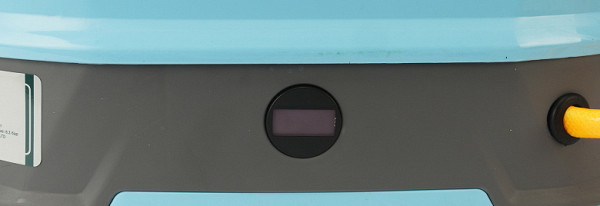
Operation
During practical use of the device, we encountered several non-obvious problems and features:
- Plastic overlay on the keys: The overlay for protecting the keys can easily get lost, as it is not securely fastened. Therefore, it is better to immediately consider it an unreliable element of the design.
- Charging connector: If you leave the charging cable connected and try to lift a heavy sprayer, the connector may jump out of the socket. However, this is easy to fix: the connector is fastened with latches, and it can be returned to its place in a matter of seconds.
- Spray range: In horizontal mode, the sprayer provides a spray range of up to 1.5 m, and with a tailwind — up to 3 m. Taking into account the telescopic tube, the comfortable working distance is about 2 m. When the tube is raised vertically, the water «fountain» reaches a height of up to half a meter, which allows you to treat trees up to 3-3.5 m high (taking into account the height of a person, the length of the tube and the spraying height).
- Adjustable straps: The backpack straps can be adjusted to a considerable distance. With a minimum belt length, the device fits comfortably on the back of a user about 180 cm high. People of different sizes, including full and broad-shouldered, will be able to comfortably use the device.
- Carrying: A plastic tank lid with a large handle allows you to carry a fully filled tank. Although the manufacturer does not mention this method of carrying, it looks reliable, and the risk of damaging the device is minimal.
- Nozzles: All nozzles, including the watering can, spray water quite finely. This is expected for a sprayer, but those who prefer nozzles with a large stream will have to take into account the lack of such an option.
The manufacturer's website provides photographs that will help you visually evaluate the operation of all nozzles.

In principle, everything is clear, visual and, as we have found out, corresponds to the real state of affairs.
Care
Important to remember: After each use, thoroughly rinse all parts of the device (tank, hose, pump, boom and nozzles) with plenty of clean water to completely remove any chemical residue. We recommend filling the tank with water at least twice and emptying it completely to ensure proper rinsing.
Chemical residues can cause corrosion and other damage, especially to nozzles, filters and seals.
Our measurements
In all tests except the practical ones, the sprinkler was tested with normal tap water at a temperature of 20°C.
We initially measured the time it took to spray a full 20-liter tank. As expected, the time varied depending on the nozzle. All data has been collected in a table for convenience. Measurements were taken with both pumps turned on and at maximum pressure.
| Sprayer type | Spray time, min:sec | Productivity, ml/s |
|---|---|---|
| Cone, one hole | 12:05 | 27.6 |
| Cone, four holes | 13:05 | 25.5 |
| Two nozzles | 8:55 | 37.4 |
| Three nozzles | 6:40 | 50.0 |
| Watering can nozzle | 6:35 | 50.6 |
As you can see, the spray rate varies depending on the cone setting, and the shower-type nozzle uses up water the fastest. We used it in the following test to find out how long the sprayer can work on a full battery charge and how much liquid it can process during this time.
Considering that the battery has an impressive resource (from 2 to 10 hours of operation), and there is no option to connect to an external tank, we decided to measure the operating time in an original way: we used a watering can nozzle (which uses up water the fastest), lowered it into the sprayer tank and made the device circulate water.
To work at maximum capabilities, we turned on both pumps and the stirrer. The results were as follows:
- The sprayer worked for 2 hours and 10 minutes at full power.
- After that, the charge indicator showed that the battery was discharged (and the display went out), but the device continued to work for about half an hour with significantly less power. In this mode, the sprayer can be used for slow spraying of bushes and lawns if the charge is not enough for full use.
- In 2 hours and 10 minutes, 395 liters of liquid (about 400 liters) were sprayed, which is the maximum volume without recharging. This is equal to 20 full tanks. Considering the time for adding water (which is approximately equal to the spraying time or more), it can be said that the sprayer can be used for up to 4 hours, of which 2 hours are for work, and another 2 hours for refueling.
The result is impressive.
When charging the battery, the charger consumes up to 18.4 watts. A full charge from a completely discharged state takes 19 hours. Thus, after a working day, the sprayer can be left to charge overnight.
Practice tests
To evaluate the device's capabilities, we went to a nearby lawn and tested all the attachments to see how they handled spraying and water delivery. The weather was sunny, which made testing especially visual: the water spray was easy to track thanks to the rainbow.
Here's how the different attachments work:
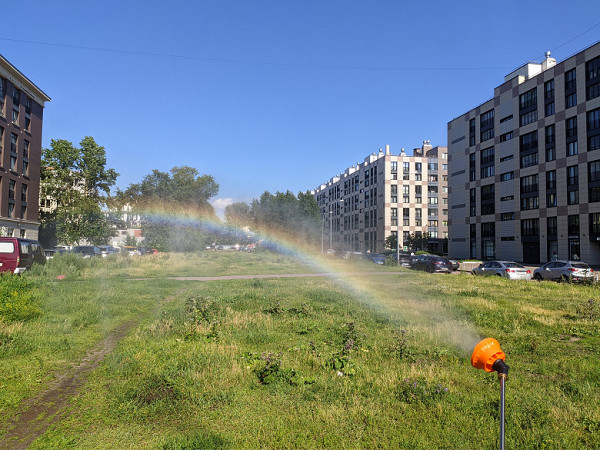
Watering can nozzle
This «watering can» is designed to spray water with a narrow cone at high intensity, not for watering. It is convenient to work at a distance of up to 1.5 m from the nozzle in windless weather. The maximum spray range that we recorded was up to 3 m at maximum power and the nozzle positioned at a height of about 2 m.

Precision Spray Nozzle (Single Hole)
The single-hole nozzle produces a fairly wide spray cone, with a comfortable working distance of about 1 m (again, from the nozzle tip).

Four-hole nozzle
Four holes produce a fairly high intensity of small drops, which can be used to treat plants at a distance of about 1.5 m.
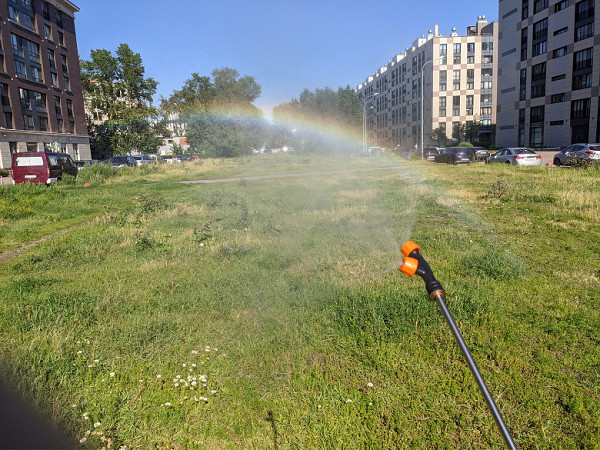
Nozzle with two sprayers
Two sprayers are twice as big as one. The area of treatment is doubled without any noticeable reduction in the spraying range.

Three sprayers
What could be better than two sprayers? Three, of course! The volume of water or solution supplied increases by about a third, but the treatment area expands slightly. Thus, the area will be treated in the same way as before, but with greater intensity.
Below are additional photos.
A single sprayer is ideal for the care of small flower beds...
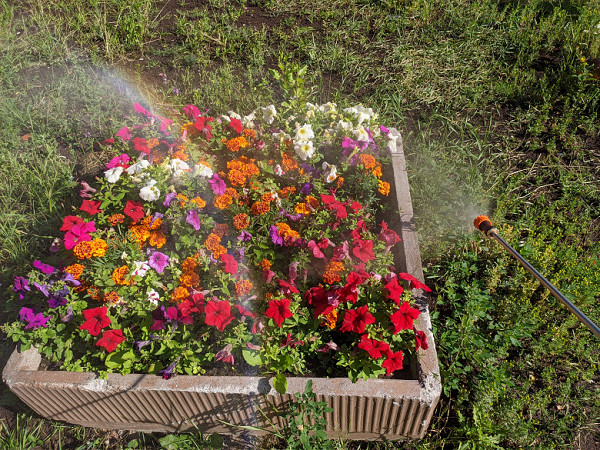
...and also for spraying bushes and low trees.
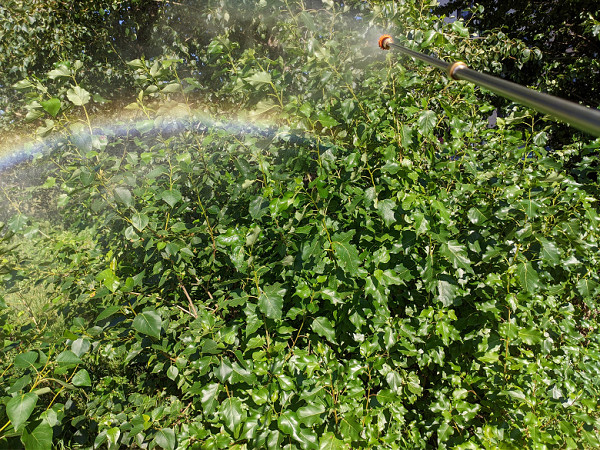
What about spraying tall trees?
The height to which our sprayer can spray water is limited. Within one telescopic tube and about 0.5 m of water jet, it does not reach significant heights. However, when using chemicals, this mode may be inconvenient because splashes may fall on the user.
Conclusions
Testing the Tornado Pro ZFB-20 battery garden sprayer was a fascinating and educational experience. At first glance, it was clear that this is a powerful device suitable for serious gardeners and vegetable growers. And our assumptions were confirmed: the sprayer is capable of processing impressive volumes of vegetation, pumping up to 400 liters of water or solution on a single charge!
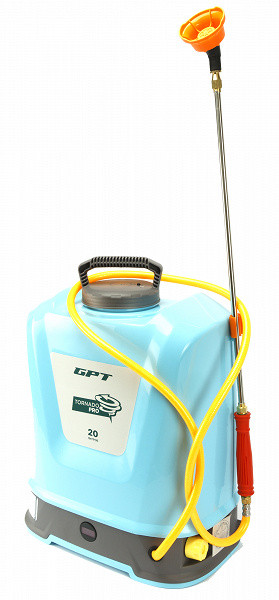
Overall, the impressions from using the Tornado Pro ZFB-20 battery-powered garden sprayer are positive. The straps, backrest, hose and telescopic tube mounts are all well thought out and really provide comfort when working.
However, before buying, you should soberly assess your capabilities. Are you ready to carry a backpack weighing about 27 kg, which quickly empties? This means regular trips to a water source, removing the backpack, filling it up and returning to the work site — a process that could be simplified with the help of a second person for filling.
Since the sprayer does not have the ability to connect to a stationary water source, and the model is intended mainly for working with chemicals, do not forget about the labor intensity of the process of preparing solutions. Experienced gardeners will probably not be afraid of such features and will appreciate the functionality of this device.
Pros:
- Simple and well-thought-out design
- High performance
- Many attachments included
- Impressive battery life
Cons:
- It is impossible to connect a hose from an external tank



